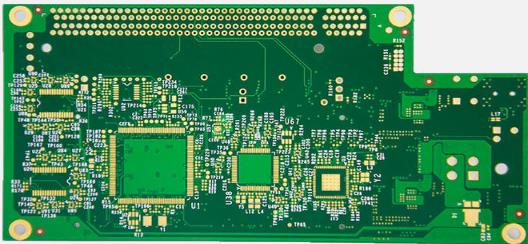PCB electromagnetic interference
There are two main types of PCB interference. One comes from the inside of the PCB. It is mainly due to the crosstalk of the signal along the transmission path due to the parasitic coupling between adjacent circuits and the field coupling of internal components. For example, capacitors on PCBs, especially those used in high frequency applications. We can think of it as an LCR circuit, because when a capacitor actually works in a circuit, it generally produces equivalent inductance and impedance. The capacitor has a self-resonant frequency. At the self-resonant frequency, the capacitor is capacitive. Above the self-resonant frequency, the capacitance is inductive, and the impedance increases as the frequency increases.
Another type of electromagnetic interference comes from the outside of the PCB, which is divided into two types: radiation interference and sensitive elements. Radiation mainly comes from the harmonic sources of clocks and other periodic signals. There are also some electronic equipment or instruments due to voltage and power jumps that generate second harmonics.
Avoid PCB electromagnetic interference, mainly from the following points:

1. Reasonable design schematic diagram
When designing a circuit board, the first thing to be done is the design of the schematic diagram. The design schematic diagram is generally operated by Altium Designer software, and all the components used can be filtered in the schematic library. If there is no component to be selected in the schematic library, you can draw it yourself. After drawing the schematic diagram, it is necessary to perform automatic detection to check whether there are obvious errors in the drawing process.
After the schematic drawing is completed, the printed circuit board can be designed. The results of automatic routing are always unsatisfactory, requiring manual layout and routing. When designing printed circuit boards, electromagnetic compatibility has become an important technical requirement to be considered. Reasonable layout of components and circuits in printed circuit boards can effectively reduce electromagnetic interference problems.
2. Choose a capacitor whose equivalent inductance and resistance are relatively small
The problem of crosstalk should also be paid attention to. Crosstalk is the coupling of energy from one wire to another. According to the phenomenon of Faraday electromagnetic induction, when a wire passes current, a magnetic field will be generated around the wire. The interaction of the magnetic fields of different wires produces crosstalk. Mutual inductance is one of the mechanisms that produce crosstalk, and its magnitude is proportional to the current in the wire.
3. Limit the periodic signal to an area as small as possible
Mutual capacitance is another mechanism that produces crosstalk, which is produced by the coupling of two electrodes through an electric field. The solution is to limit the periodic signal to a small area as much as possible and block the path of parasitic coupling with the outside world. When necessary, filter can be used to filter; the external sensitivity is mainly radio frequency interference and electrostatic discharge, etc., to solve this problem You can use shielding, good grounding and filtering methods.
4. Anti-interference methods when designing printed circuit boards
1) Selection of PCB board materials. Printed circuit boards are divided into single-sided, double-sided and multi-layer boards. Epoxy glass cloth is most commonly used as the substrate. This material has the following advantages: Good expansion, which is beneficial to reduce the loop area, reduce differential mode interference, low water absorption, heat resistance, chemical corrosion resistance, and impact resistance Good performance.
2) PCB wiring. When wiring, follow the principle of minimum flux. The principle of minimum flux means that the magnetic lines of force generated by the transmission line and the return path cancel each other to realize the cancellation of electric flux. The single panel has no ground plane, and the main point of its wiring is to reduce the loop area of the power loop and the signal loop. Use protective grounding for wiring. Pull out the ground wire close to the power wire or signal wire and route it together to reduce the loop area. High-speed signal routing should be straight or obtuse, and there should be no acute or right angles.
3) PCB layout. Generally, PCB design software has the function of automatic layout, but this function does not meet the needs of actual work, so the designer is required to be familiar with the layout rules. In the layout, the digital circuit part and the analog circuit part should be separated, leaving a part of the space in between. The layout should be divided according to high-speed, medium-speed, low-speed, and I/O circuits to reduce the interference of high-speed circuits on other parts.
in conclusion
The design of the printed circuit board is a complicated process. There are many factors that need to be considered when designing. A little carelessness will have a great impact on the performance of the circuit board. In the design process, if the electromagnetic compatibility issue is not fully considered, the designed circuit board may not be put into use normally. Therefore, in the PCB design, the wiring, layout, grounding, shielding and other issues should be fully considered, and crosstalk between the signals should be taken into consideration.